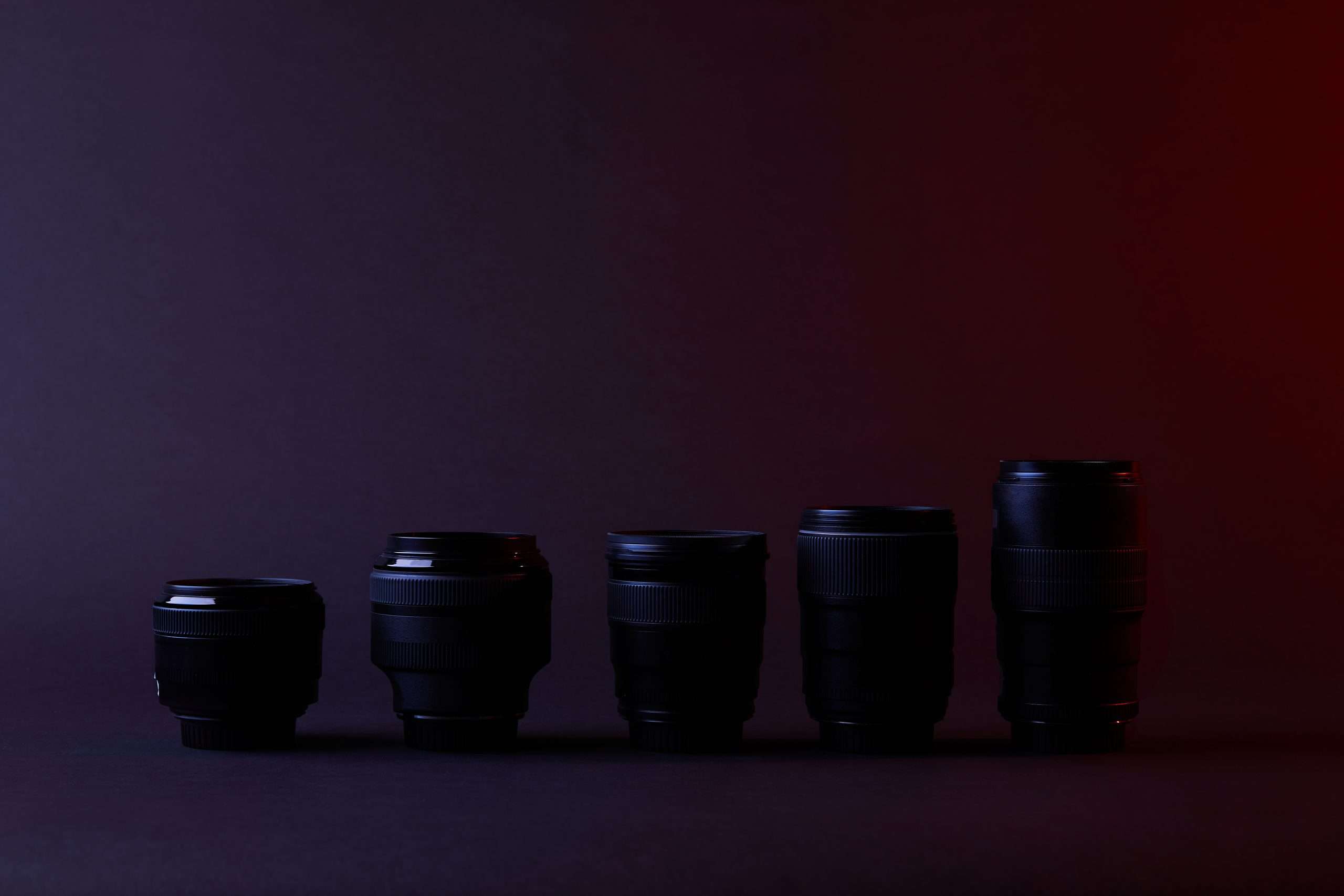Welcome to the world of photography! In this section, we will delve into the fundamentals of
camera lenses and explore their various uses.
A lens is a transparent optical device that can focus or disperse a light beam by refracting it. There are two main types of lenses: concave and convex. A convex lens causes light rays to converge to form a real image, while a concave lens causes light rays to diverge. Lenses are used in various devices such as telescopes, binoculars, and cameras. They can also be used in glasses to correct vision problems. Lenses can be made of glass or plastic and can have different shapes, sizes, and materials. The shape and curvature of a lens determine its focal length and its ability to focus or disperse light. Different types of lenses, such as bi-convex, bi-concave, plano-convex, concavo-convex, plano-concave, and convexo-concave, have different properties and uses. Real images can be projected or viewed without additional lenses, while virtual images can only be viewed or projected with the aid of another lens.
Key Takeaways:
- Camera lenses are transparent optical devices that focus or disperse light
- There are two main types of lenses: concave and convex
- Lenses are used in telescopes, binoculars, and cameras
- Lenses can be made of glass or plastic and come in different shapes, sizes, and materials
- Different types of lenses have different properties and uses
When it comes to lenses, there is a wide range of options available, each with its unique characteristics and purposes. Understanding the different types of lenses is crucial for photographers to choose the right one for their specific needs.
One common type of lens is the prime lens, which has a fixed focal length. Prime lenses are known for their sharpness and wide maximum aperture, making them ideal for portrait photography and low-light situations. On the other hand, zoom lenses offer a variable focal length, allowing photographers to zoom in and out without changing lenses. This versatility makes them popular for travel and wildlife photography.
Wide-angle lenses have a short focal length and capture a wider field of view, making them great for landscape and architectural photography. Telephoto lenses, on the other hand, have a longer focal length and bring distant subjects closer, making them ideal for sports and wildlife photography. Macro lenses are designed for close-up photography, allowing photographers to capture intricate details with high magnification.
To further enhance the capabilities of lenses, photographers can explore various features and settings. Autofocus helps in achieving sharp images by automatically adjusting the focus. Image stabilization reduces the impact of camera shake, enabling photographers to capture blur-free shots. Aperture settings control the amount of light entering the camera, affecting depth of field and brightness. Lens zoom capabilities allow photographers to adjust the focal length and composition without moving.
In conclusion, understanding the different types of lenses and their features is essential for photographers to make informed decisions. By choosing the right lens for the job and utilizing its capabilities effectively, photographers can enhance their creative vision and capture stunning images.
| Lens Type |
Characteristics |
Purposes |
| Prime Lens |
Fixed focal length, sharpness, wide maximum aperture |
Portrait, low-light photography |
| Zoom Lens |
Variable focal length, versatility |
Travel, wildlife photography |
| Wide-angle Lens |
Short focal length, wide field of view |
Landscape, architectural photography |
| Telephoto Lens |
Longer focal length, brings distant subjects closer |
Sports, wildlife photography |
| Macro Lens |
Close-up photography, high magnification |
Detail-oriented photography |
Exploring lens features and settings
To maximize the potential of your camera lens, it is essential to understand the different features and settings that can enhance your photography experience. From autofocus capabilities to aperture settings, these features can greatly impact the quality of your images and give you more control over your shots.
One important feature to consider is autofocus. This allows your lens to automatically focus on the subject you are shooting, ensuring sharp and clear images. Most cameras offer various autofocus modes, such as single-point autofocus, continuous autofocus, and automatic autofocus, giving you the flexibility to choose the most appropriate setting for different shooting situations.
Another crucial setting is the aperture. The aperture controls the amount of light that enters the camera lens, as well as the depth of field in your images. A wider aperture (smaller f-number) allows more light to enter, resulting in a shallower depth of field and a blurred background, ideal for portraits or close-up shots. On the other hand, a narrower aperture (larger f-number) increases the depth of field, keeping both the foreground and background in focus, which is useful for landscapes or architectural photography.
| Feature |
Function |
| Autofocus |
Automatically focuses on the subject |
| Aperture |
Controls the amount of light and depth of field |
| Image Stabilization |
Reduces camera shake for sharper images |
| Zoom |
Allows varying focal lengths to capture different perspectives |
In addition to autofocus and aperture, other important features include image stabilization and zoom capabilities. Image stabilization helps reduce camera shake, resulting in sharper images, especially in low-light conditions or when using a telephoto lens. Meanwhile, the zoom feature allows you to change the focal length of your lens, capturing a wide range of perspectives from wide-angle to telephoto.
By understanding and utilizing these various features and settings, you can unlock the full potential of your camera lens and elevate your photography skills. Experiment with different modes, explore the possibilities of aperture settings, and take advantage of autofocus and image stabilization. With practice and exploration, you will be able to capture stunning images that truly reflect your creative vision.
Understanding Camera Exposure
Achieving the perfect exposure is crucial in capturing well-balanced and visually appealing images. Understanding
camera exposure involves controlling three main factors: ISO, aperture, and shutter speed. Let’s take a closer look at each of these elements and how they contribute to creating stunning photographs.
ISO
ISO refers to the sensitivity of your camera’s image sensor. In low-light conditions, you may need to increase the ISO to capture a well-exposed image. However, higher ISO settings can introduce digital noise, resulting in a grainy appearance. On the other hand, lower ISO settings produce cleaner images but require more light. Finding the right balance between ISO and light conditions is crucial for achieving optimal exposure.
Aperture
The aperture determines the amount of light that enters the camera lens. It is represented by an f-stop number, such as f/2.8 or f/16. A wide aperture (low f-stop number) allows more light to enter, ideal for low-light situations or creating a shallow depth of field. Conversely, a narrow aperture (high f-stop number) restricts the amount of light, resulting in greater depth of field. Understanding aperture and how it affects exposure and depth of field is essential for creating the desired visual effect in your photographs.
Shutter Speed
The shutter speed dictates how long the camera’s shutter remains open, determining the amount of light that reaches the image sensor. Faster shutter speeds freeze motion, while slower speeds create motion blur. When selecting the appropriate shutter speed, consider the subject and the effect you want to achieve. A faster shutter speed is ideal for capturing fast-moving subjects, while slower speeds can create a sense of motion or emphasize long exposures.
| Camera setting |
Effect |
| High ISO |
Increased image sensitivity to light, useful in low-light conditions |
| Wide aperture |
Allows more light into the camera, creates shallow depth of field |
| Narrow aperture |
Restricts light, creates greater depth of field |
| Faster shutter speed |
Freezes motion |
| Slower shutter speed |
Creates motion blur, captures light trails |
By understanding and mastering the interplay between ISO, aperture, and shutter speed, you can take full control over your camera’s exposure settings. Experiment with different combinations to achieve the desired effect in your photographs, whether it’s freezing a fast-moving subject, capturing a dreamy long exposure, or creating a beautifully blurred background. Remember, exposure is not a one-size-fits-all formula, and it’s essential to tailor your settings to the specific conditions and creative vision for each shot.
Mastering camera settings and modes
Understanding and utilizing the different
camera settings and modes can empower you to have better control over your photographic outcomes. With the right settings, you can capture stunning images in various lighting conditions and subjects. Let’s explore some essential
camera settings and modes that every photographer should know.
1. Manual mode
In manual mode, you have complete control over all the
camera settings, including aperture, shutter speed, and ISO. This mode is ideal for experienced photographers who want to achieve precise exposure and creative effects. It allows you to adjust the settings according to the specific requirements of your subject and the lighting conditions. By mastering manual mode, you can unleash your creativity and capture images with the desired artistic flair.
2. Aperture priority
Aperture priority mode is perfect for controlling depth of field. By adjusting the aperture, you can dictate how much of your image is in focus. A wider aperture (smaller f-number) creates a shallow depth of field, resulting in a blurred background and emphasizing the subject. On the other hand, a narrower aperture (larger f-number) increases the depth of field, making more elements in your scene sharp and clear. This mode is particularly useful in portrait and macro photography, where you want to isolate your subject from the surroundings.
3. Shutter priority
Shutter priority mode is essential for capturing motion. By selecting the desired shutter speed, you can freeze fast-moving action or capture creative long exposures. A fast shutter speed freezes the action, allowing you to capture sharp images of moving subjects. Conversely, a slow shutter speed creates a sense of motion blur, making moving subjects appear dynamic and ethereal. This mode is great for sports, wildlife, and night photography.
4. Scene modes
Scene modes are pre-programmed settings designed for specific shooting conditions or subjects. They are ideal for beginners or photographers who want quick and easy solutions. Each scene mode optimizes the camera settings for a particular scenario, such as landscape, portrait, night, or sports photography. By selecting the appropriate scene mode, you can capture better images without worrying about the technical details. However, keep in mind that scene modes may limit your control over individual settings, so it’s important to understand their limitations.
| Camera Settings and Modes |
Advantages |
Disadvantages |
| Manual Mode |
Full control over camera settings; Allows for creative freedom |
Requires knowledge and experience; Can be time-consuming |
| Aperture Priority |
Control over depth of field; Ideal for portraits and macro photography |
May require knowledge of exposure compensation; Limited control over other settings |
| Shutter Priority |
Ability to freeze or blur motion; Great for sports and long exposure photography |
May need tripod or image stabilization for slow shutter speeds; Limited control over other settings |
| Scene Modes |
Quick and easy solutions for specific shooting conditions |
Limited control over individual settings; May not suit all situations |
Remember, the mastery of camera settings and modes comes with practice and experimentation. Take your time to understand each setting and mode and how they can be applied to different photographic situations. By continuously learning and honing your skills, you will be able to capture breathtaking images that truly reflect your vision as a photographer.
Unveiling the secrets of camera lenses
Camera lenses hold some hidden secrets that, once discovered, can elevate your photography to the next level. Understanding these secrets can help you make informed decisions when choosing lenses and make the most of their capabilities. Let’s dive into some of these fascinating aspects of camera lenses.
Types of camera lenses
There are various types of camera lenses designed for different purposes. Prime lenses, for example, have a fixed focal length and offer exceptional image quality. They are great for capturing portraits and low-light situations. On the other hand, zoom lenses provide flexibility by allowing you to adjust the focal length, making them suitable for versatile shooting scenarios. Wide-angle lenses are perfect for landscape photography, while telephoto lenses excel at capturing distant subjects like wildlife or sports events. Macro lenses are specifically designed for close-up photography, allowing you to capture intricate details.
Controlling lens aberrations
Camera lenses can sometimes introduce certain optical aberrations that affect image quality. Two common types of aberrations are lens distortion and chromatic aberration. Lens distortion can cause straight lines to appear curved, especially in wide-angle lenses. Chromatic aberration, on the other hand, results in color fringing around high-contrast areas. To minimize these aberrations, many lenses come with built-in corrective measures. However, for precise control, you can also use specialized lens filters or hoods that help reduce unwanted light and glare.
Choosing the right lens for your needs
When selecting a lens, it’s essential to consider your specific photography needs and style. Are you interested in capturing landscapes, portraits, or macro shots? Understanding the characteristics of different lenses can help you choose the one that suits your vision. Additionally, knowing the technical specifications, such as focal length, maximum aperture, and image stabilization, can greatly impact your ability to capture stunning images in various conditions. Take your time to explore different lenses and experiment with them to discover the secrets they hold.
| Lens Type |
Main Features |
Best For |
| Prime lenses |
Fixed focal length, excellent image quality |
Portraits, low-light photography |
| Zoom lenses |
Adjustable focal length, versatile |
Various shooting scenarios |
| Wide-angle lenses |
Capturing expansive landscapes |
Landscape photography |
| Telephoto lenses |
Long focal length, capturing distant subjects |
Wildlife, sports photography |
| Macro lenses |
Extreme close-up capabilities |
Detail-oriented photography |
Exploring the secrets of camera lenses is an ongoing journey that can significantly enhance your photography skills. By understanding the different lens types, controlling optical aberrations, and choosing the right lens for your needs, you can unlock the full potential of your camera and capture extraordinary images.
Optimizing camera performance in South Africa
South Africa offers a diverse range of photographic opportunities, and optimizing your camera performance can help you capture unforgettable moments in this beautiful country. Whether you’re capturing the breathtaking landscapes of the Drakensberg Mountains, the vibrant wildlife in the Kruger National Park, or the vibrant street scenes of Cape Town, having the right camera settings and techniques can make all the difference in capturing stunning images.
Understanding lighting conditions
One of the key factors in achieving exceptional photographs is understanding the lighting conditions. South Africa’s diverse climate and landscapes can present unique challenges and opportunities when it comes to lighting. For example, shooting during the golden hour – the hour after sunrise or before sunset – can result in soft, warm lighting that adds a magical touch to your images. On the other hand, photographing during midday can create harsh shadows and overexposed areas. Being aware of these lighting conditions and adjusting your camera settings accordingly can greatly enhance the quality of your photos.
Choosing the right lenses
When photographing in South Africa, having the right lenses can greatly enhance your ability to capture the essence of this diverse country. For wildlife photography, a telephoto lens with a long focal length is essential to capture animals in their natural habitats without disturbing them. If you’re interested in capturing the wide landscapes and majestic scenery, a wide-angle lens can help you showcase the vastness and beauty of South Africa’s natural wonders. Additionally, a macro lens can allow you to capture the intricate details of the flora and fauna found in this country.
Remember to protect your lenses from dust, dirt, and harsh weather conditions by using lens filters and lens hoods. These accessories can not only protect your lenses but also enhance the overall image quality by reducing glare and improving contrast. Lastly, it’s important to clean your lenses regularly to ensure clear and sharp images.
Mastering composition and post-processing
In addition to technical aspects, mastering composition techniques can take your photography to the next level. Experiment with different angles, perspectives, and framing to create visually compelling images. Pay attention to leading lines, rule of thirds, and symmetry to create a well-balanced composition that draws the viewer’s eye. After capturing your images, post-processing can further enhance the visual impact. Explore software tools like Adobe Lightroom or Capture One to adjust exposure, contrast, and colors to bring out the best in your photographs.
| Tip |
Summary |
| Study the weather and lighting conditions |
Understanding the lighting conditions in South Africa can help you plan your photography outings and make the most of the available light. |
| Invest in the right lenses |
Choosing the right lenses for various types of photography can greatly improve the quality and impact of your images. |
| Master composition techniques |
Experimenting with different composition techniques can help you create visually stunning images that engage the viewer. |
| Utilize post-processing tools |
Using post-processing software can further enhance your images, allowing you to fine-tune exposure, contrast, and colors. |
Conclusion
In conclusion, understanding the basics of camera lenses is essential for any aspiring photographer looking to enhance their skills and capture stunning images. Camera lenses play a crucial role in photography, allowing photographers to control the focal length, depth of field, and perspective of their shots.
By familiarizing yourself with the different types of lenses available, such as prime lenses, zoom lenses, wide-angle lenses, telephoto lenses, and macro lenses, you can choose the right lens for each photographic situation.
Additionally, mastering camera settings and modes, such as manual mode, aperture priority, shutter priority, and scene modes, empowers photographers to have greater creative control over their images.
Furthermore, it’s important to be aware of the various features and settings that camera lenses offer, such as autofocus, image stabilization, and aperture settings. Having a solid understanding of these features allows photographers to optimize their camera’s performance and capture sharp, well-exposed photographs.
So, whether you’re shooting landscapes, wildlife, or urban photography, in South Africa or anywhere else, understanding camera lenses will undoubtedly elevate your photography skills and enable you to capture truly exceptional images.
How Should I Clean and Maintain My Camera Lenses?
When it comes to cleaning camera lenses, there are a few essential cleaning camera tips to keep in mind. Always start by using a blower brush or air blower to remove any loose dust or debris. Then, gently wipe the lens surface using a microfiber cloth, avoiding excessive pressure. For stubborn smudges or fingerprints, use a lens cleaner solution and lens tissue paper. Regular maintenance and careful cleaning will help prolong the lifespan of your camera lenses.
FAQ
What is a lens?
A lens is a transparent optical device that can focus or disperse a light beam by refracting it.
What are the two main types of lenses?
The two main types of lenses are concave and convex.
What is the difference between a convex and concave lens?
A convex lens causes light rays to converge to form a real image, while a concave lens causes light rays to diverge.
Where are lenses commonly used?
Lenses are used in various devices such as telescopes, binoculars, cameras, and glasses to correct vision problems.
What materials can lenses be made of?
Lenses can be made of glass or plastic and can have different shapes, sizes, and materials.
How do different types of lenses differ?
Different types of lenses, such as bi-convex, bi-concave, plano-convex, concavo-convex, plano-concave, and convexo-concave, have different properties and uses.
What is the difference between a real image and a virtual image?
Real images can be projected or viewed without additional lenses, while virtual images can only be viewed or projected with the aid of another lens.






